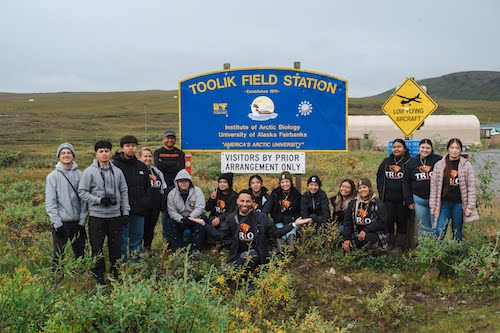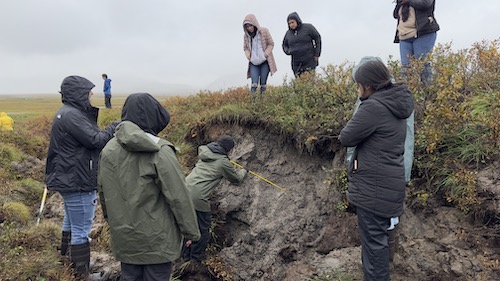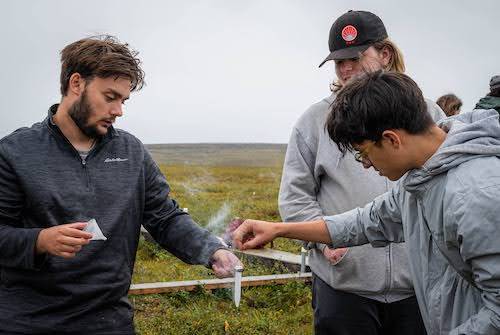New climate program launches underserved students into Arctic science
Haley Dunleavy
907-474-6407
Oct. 6, 2023

Oregon State University Upward Bound students and chaperones stand in front of the Toolik Field Station sign.
Driving Alaska’s Dalton Highway, the rugged 400-mile road that stretches from north of Fairbanks to Prudhoe Bay, is the trip of a lifetime for many. But 12 recent travelers from Oregon met this bucket list item before even graduating from high school.
The trip was part of a new collaboration between the University of Alaska Fairbanks’ Toolik Field Station, Oregon State University, and the University of Maine’s Juneau Icefield Research Program to boost climate education for students from underrepresented groups in polar science.
In late August, 12 students from OSU’s TRIO Upward Bound program spent five days at the field research station, which is part of the Institute of Arctic Biology at UAF. The students participated firsthand with Toolik Field Station staff, scientists, artists and others responding to the warming Arctic.
Amas Aduviri, who oversees Upward Bound as director of OSU’s Student Access and Enrichment Programs, said the program’s inaugural trip to the Arctic was a success.
“We need to provide more of these types of opportunities for first-generation and low-income students,” Aduviri said, noting the impact the program had on students. “They are planning to get better grades, are more motivated to graduate from high school and are now seeing college as a real possibility.”
Upward Bound is a federal program that promotes education equity, access and opportunity for students who are either from low-income backgrounds or would be first-generation college students.

Students take turns touching exposed ground ice where the ground collapsed because of thawing permafrost near Galbraith Lake.
At the station, students withstood Arctic rain and fog to take part in all aspects of Arctic science, technology, engineering, arts and math. Toolik staff coordinated field activities, which included diving into ground collapse caused by thawing permafrost, capturing 3D imagery with drones and photogrammetry, and walking among burned spruce trees in a recent Arctic wildfire scar.
The students also spoke with scientists and support staff about the wide range of science-related careers, wrote haikus about the science at Toolik and workshopped watercolor paintings of the tundra with visiting artist-in-residence Kristin Link. They even helped researchers collect samples for an ongoing study of tundra plant genetics.
Erin Towns, a graduate student at the University of Maine and high school teacher of 25 years who helped lead the trip’s curriculum, said the program empowered students to see the many different ways they could work toward a career in polar science.
“Their curiosity was an absolute pleasure to watch,” she said. “It takes such a large team of researchers, crafts and trades people, technicians, mechanics, pilots, cooks, and more to make science in the Arctic successful, and the students were really excited about it.”
Back home in Oregon, the participants are preparing to share their experience with other students who completed a similar program in Juneau. It has left some with a deeper sense of responsibility to the environment.
“[The program] has opened my mind to how what we do affects environments that we don’t even live nearby,” wrote one student in a post-experience survey. “I’m more thoughtful about what I buy or waste.”

Students Gustavo Villegas, right, and JayDen Viles, back, help researcher Wes Mahler, left, collect plant samples at Toolik Field Station.
Junior Yatzareht Ramirez Lira encouraged others to join in future years.
“Although it’s something super different than what we are used to, it’s honestly a wonderful experience to live like a research scientist and see what their day-to-day life looks like,” she said. “It’s not every day you are given the opportunity to visit the Arctic.”
The program was funded at no cost to the students by educational grants from Battelle and the U.S. Department of Education.
After completing a successful first run, Aduviri said he plans to continue the program for years to come.
Towns agreed. “[This program] sparked something in the students to pay attention to the planet and the environment, and I think that’s not just a short-term impact. That’s for life,” she said.
059-24



